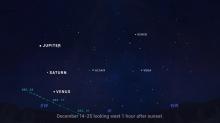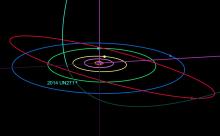Listen to today's episode of StarDate on the web the same day it airs in high-quality streaming audio without any extra ads or announcements. Choose a $8 one-month pass, or listen every day for a year for just $30.
You are here
Leonid Meteors
A quiet but steady meteor shower is building toward its peak tomorrow night. The gibbous Moon will steal most of its luster, though. Only a few “shooting stars” will shine through the moonlight.
The shower is called the Leonids because its meteors appear to “rain” into the sky from Leo. The lion climbs into view in the wee hours of the morning.
But there’s no relation between the meteors and the constellation. Instead, the meteors are the offspring of a comet.
The comet was first seen by Ernst Tempel, in December 1865, and Horace Tuttle a few weeks later, so it carries both of their names — Tempel-Tuttle.
Not long after the discovery, several astronomers noted a similarity between the orbit of Tempel-Tuttle and the Leonid meteor shower. They realized that the comet must somehow spawn the shower.
And they were right. A comet is a ball of frozen water and gases mixed with bits of solid rock. When it gets close to the Sun, some of the ice vaporizes, releasing solid particles. When Earth crosses the comet’s path, these particles slam into the atmosphere, forming the glowing streaks known as meteors.
The Leonids are best when the comet is closest to the Sun, and when Earth passes through a dense part of the stream of comet dust. Neither of those will happen this year, so the shower is pretty weak. Even so, if you have a dark, safe viewing spot, it’s worth looking for those few meteors — the offspring of a comet.
Script by Damond Benningfield






